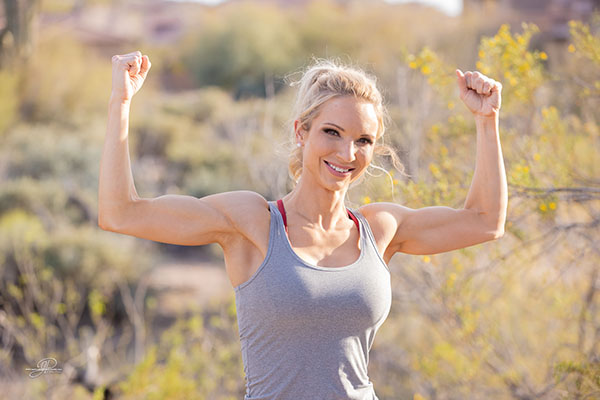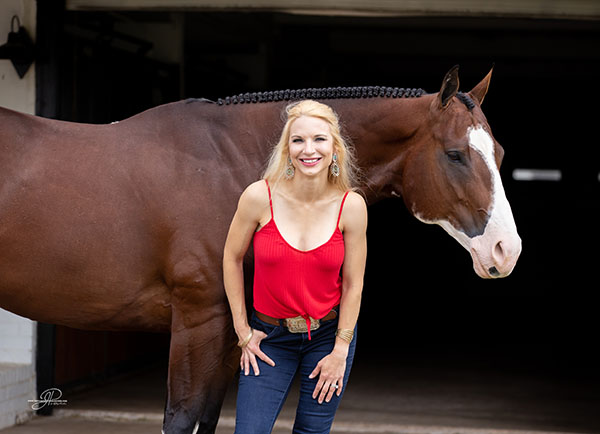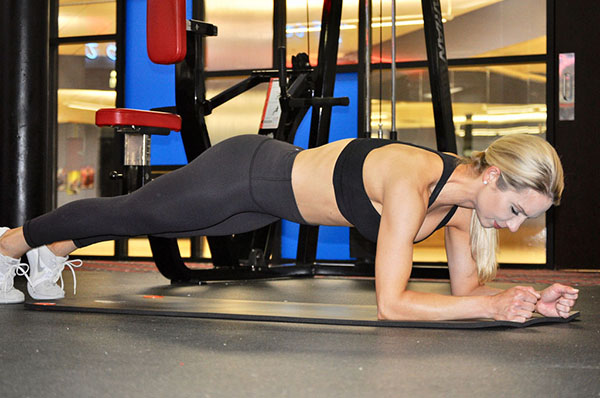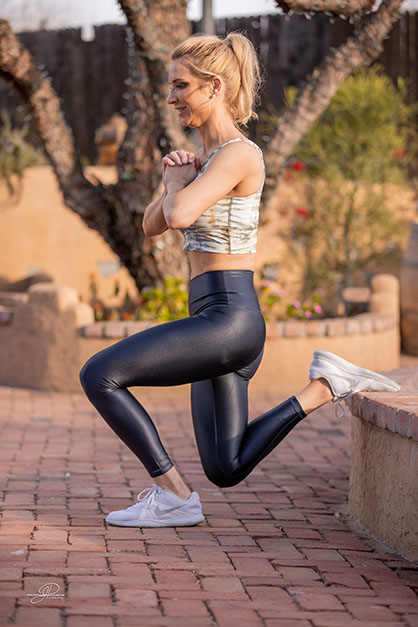5 Equestrian Exercises For Getting into Show Shape

By: Brittany Bevis
Right now, you’re probably creating a show calendar for the new year, fine tuning your horse’s skills, and revamping your tack and attire. But have you given any consideration to your own fitness level?
Taking some time away from riding during the off season, and indulging a bit during the holidays, is enough to make even the most seasoned competitor feel slightly off their game. Even if you’re putting in the daily work to develop your own riding skills, there’s likely a part of the puzzle that’s still missing- strength and conditioning- and not for your horse.
“I already ride horses. That’s my workout for the day.”
True, but consider this. At the top level of this sport, the smallest changes can make the difference between first and fourth place. You might spend hours perfecting your horse’s flying lead change or the perfect pivot, but are you lacking the core or leg strength to hold it all together and create that perfect picture?
Bottom Line: If you’re expecting to compete at an elite level, where talent and resource levels are near equal, any small advantage matters.
The Expert
Jenna Tolson, an APHA amateur and the owner of Ride Fit Life, is here to help with five exercises to get you into show shape.
Jenna started showing horses, like most, in open shows as a DIY competitor. Her first foray onto the big stage was The Equine Chronicle Color Classic 2-Year-Old Western Pleasure at the Reichert Celebration in 2009. Showing her homebred filly, Sensational Whiteout, to a fourth place finish behind Mike Hatchel, Sara Simons, and Jana Simons is something she considers one of the greatest moments of her life. Since then, she’s expanded into the Hunter Under Saddle side of APHA and has competed with her 10 time World and Reserve World Champion mare, TheFairestOfThemAll, for the past eight years.
Interestingly enough, Jenna hasn’t always been focused on health and fitness. She lives with three autoimmune diseases- Type 1 Diabetes, Hashimotos Thyroiditis, and Crohn’s Disease. Six months before her 30th birthday, she set a goal to be in the best shape of her life, and the transformation awakened an entirely new passion.
“Truthfully, I didn’t start working out as a way to manage my health; but, once I saw how incredibly beneficial it was, especially when it comes to controlling my blood sugars, it provided even more motivation. I’ve never let my diabetes, nor any of my diseases, be an excuse for why I can’t do something. It requires a lot more pre-planning on my part, but I refuse to let any of it slow me down.”
 Health Matters
Health Matters
Jenna is a big believer that a specific fitness regime not only benefits overall health and well-being; it can help equestrians gain a competitive edge.
“Riding horses is an athletic event,” she says. “But the best part is we don’t have to be an elite level athlete to participate in it! Horses are so accommodating for people of all athletic abilities. In short, riding horses has the unique ability make us more capable in our own bodies. Thus, I believe we owe it to them to give them the best version of us that we can!”
“Wouldn’t you like to be able to make it through that marathon trot the first direction in a Hunter Under Saddle class? Or flawlessly execute running with your horse in these big, long, Showmanship patterns? Wouldn’t you like NOT to feel like the weak link in your partnership with your horse? We ask them to be very fit and perform for us. I think it’s fair to give that back to them.”
An equestrian in peak physical condition can benefit in a number of ways:
- Make sound mental decisions under a fatigued state
- Follow the movement of the horse
- Sit the trot without bouncing and losing weight in the stirrups
- Control the core and maintain balance in a spooky situation
- Communicate cues more clearly to the horse
- Keep a seat that’s soft and relaxed but firm and stable
- Avoid having “jelly legs” through better cardiovascular fitness
- Sit tall and straight in the saddle with shoulders back and square
- Increase resilience and prevent injuries by eliminating side-to-side body imbalances
- Have increased body awareness, improved coordination, and proprioception
Top 5 Exercises For Equestrians
As equestrians, and also as a culture of people that spend a large part of their day sitting behind a desk, Jenna believes we need to prioritize strengthening the posterior chain (back, glutes, hamstrings) and core. Isometric core exercises are among some of her favorites for equestrians, because they train the deep muscles of the core.
“These are key for balance, stability, and postural support in the saddle. Rather than thinking about crunches and sit ups, try incorporating all kinds of plank variations, as well as stomach vacuum exercises. For the posterior chain, you can’t go wrong with any kind of deadlift variation, like a Romanian deadlift. You can do these with bodyweight only, or with load, and single-leg or double leg progressions. It’s really scalable to all fitness levels and abilities.”

Planks are great for developing your core.
“Also, strengthening our hip flexors through full hip extension with glute bridges or hip thrusts is an excellent tool for establishing a solid base of support in the saddle.”
Her favorite exercise for leg strengthening is the rear foot elevated (or Bulgarian) split squat. “This is a single leg exercise, so it helps remove asymmetries from side-to-side and also works on balance and coordination. It trains your adductors (those inner thigh muscles) and works your hip stabilizer muscles too. They’re tough, but you will thank me when you see how much they help you in the saddle!”
*Note: The following exercises are simple bodyweight exercises you can do at home. If you want to increase the difficulty, use any household or barn object that has the right amount of weight. Think outside the box like a bag of grain, bucket with feed, or backpack filled with books.
Exercise #1- Bird Dogs
(Do 3-4 sets of 8-12 repetitions.)
- Get on all fours with your hands under your shoulders and knees under your hips. Your shoulders should be relaxed and your spine neutral.
- Focus your eyes on the floor and have a slight bend in your elbows.
- Take a deep breath in. As you breathe out, draw your belly button up towards your spine.
- Slowly lift and extend one arm and the opposite leg.
- Completely straighten the leg, keeping it in line with your hips, and the foot flexed.
- Hold the arm and leg for 10 seconds.
- Return to the starting position, placing your hand and knee on the floor. Repeat on the other side to complete one rep.
*If this exercise is too difficult in the beginning, raise only your leg or your arm, or start with a simple static plank hold.
Exercise #2- Inverted Row Using a Table Top
(Do 3-4 sets of 8-10 repetitions.)
- Position yourself under a table lying face up.
- Grab the table with an overhand grip that’s slightly wider than shoulder-width with palms facing away from you.
- Contract your abs and butt, and keep your body a completely straight line. Your ears, shoulders, hips legs, and feet should all be in a straight line, like you’re doing a plank.
- Pull yourself up to the bar/table until your chest touches the table.
- Lower yourself back down slow and controlled with proper form.
Exercise #3- Single Leg Glute Bridge
(Do 3 sets of 8-10 repetitions per side.)
- Lie face up on a mat. Bend your knees so your feet are flat on the floor with heels under knees.
- Bring one foot up and place it so that your ankle is resting on the thigh of your opposite leg.
- Push through the heel that’s on the ground, lifting your hips up to the point where there is a straight line from your chest to your knee. Squeeze your butt at the top of the movement.
- Lower until your butt is just above the ground and lift again.
- Keep your hips aligned throughout the whole movement.
Exercise # 4- Romanian Deadlifts
(Do 3-4 sets of 12-15 repetitions.)
RDL’s are a simple, but not necessarily easy, movement to master. They’re extremely applicable to riders though, so it’s good to spend the time mastering the hip-hinge movement.
- To learn the correct movement pattern, hold a dowel rod/PVC pipe behind your back so your top hand is even with the curve of your neck, with your palm facing inward. The bottom hand should be even with the curve of your lower back, with your palm facing outward.
- The dowel rod/PVC pipe should have three points of contact with your body (i.e., the back of your head, the thoracic spine and top of your sacrum).
- Next, stand with your feet about hip-width apart and about 6-8″ away from the wall while facing away from it. Bend your knees slightly and shift your hips back toward the wall as you want to make contact with it.
- While hinging at the hips, you want to simultaneously lower your torso until it is parallel or slightly above parallel to the floor.
- Return to standing position by contracting your hamstrings and glutes.
- Allow the knees to bend about 10-15° and the rest of the movement occurs from hinging at the hips. Do not let your back round.
- Once you master the hip-hinge movement, while keeping a flat back, you can add load by holding some type of weight in your hand.

Bulgarian split squat
Exercise #5 Rear-foot Elevated Split Squats (Bulgarian split squats)
(Do 3 sets of 10-12 repetitions per side.)
- Stand tall in a split squat stance with your back foot elevated on a bench, box or chair with shoe laces down.
- Bend both knees and lower your hips straight down toward the ground.
- Lower down until your front thigh is parallel to the floor or slightly below depending on your flexibility.
- Without touching the back knee to the ground, push down through the front leg, driving the body up and back to the start position.
- Continue for the prescribed number of repetitions; switch sides and repeat on the other side.
- If these are too difficult, start with walking lunges.
Tips For Getting it All Done
Equestrians are busy folks. How are we supposed to care for our horses, make dinner, keep a full time job, fulfill family obligations, AND workout?
“Make it realistic. Someone could give you a dynamite plan to follow to get into the best shape of your life, but it won’t do you a bit of good if you can’t remain adherent to it! The single biggest problem I see is that a person gets motivated and then decides to jump right into the deep end without learning to swim first. They slash their calories unnecessarily low and add in a whole bunch of activity, which is usually a ton of cardio. It only takes a week or two for people to get fed up, decide they can’t live this way, burnout, and go back to doing nothing and bad eating habits. After repeated cycles of doing this, we lose our self-efficacy to believe we can make a lasting change.”
“Fitness needs to be flexible so that it can ebb and flow with the various circumstances we encounter in regular life. We need to get away from thinking fitness is either ALL ON or ALL OFF and rather think of it as being on a dimmer switch instead. Being fit and healthy needs to always be ‘on,’ but we can adjust the intensity of our focus around it to match our lifestyle at any given time. That way we never stray too far to accomplishing what we desire but we also remain flexible in our pursuit.”
Jenna believes that 30-45 minutes of structured resistance training a few days per week can do wonders for your health, functional fitness level, and body composition. “It doesn’t take as much as most people think.”
“Constant traveling, irregular show schedules, eating out, little sleep, and caring for animals are just a few of the major differences horse people have to be able accommodate. I live in the trenches of both the health and fitness world and the horse show world, so I think I can offer a unique and helpful perspective to blend them together.”
Within her business, Ride Fit Life, Jenna offers online-based fitness and nutrition coaching tailored specifically towards equestrians. “Through my metabolic restoration method, I help equestrians with sluggish metabolisms slim down and shape up without crash diets, tortuous methods, and demonizing favorite foods.”
“I’ve gotten to know so many amazing and impressive women through this business of mine within the last year. A couple of my clients were even ‘in the trophies’ at the NSBA and AQHA World Shows this past year. I take no credit for any of their accomplishments, but I feel like I get to be a VIP spectator to these triumphant moments in their lives, and that’s especially meaningful.”
NSBA World Champion in Select Showmanship, Amy Engelskirger- “My goal when I signed up with RFL was to be a stronger and more effective rider. I wanted to be competitive at the World Show level! What I received in turn was not only a stronger, fitter me but a wealth of tools to use in my daily life and personal show preparation. My energy levels increased, my sleep quality improved, and I had the stamina to endure long, grueling show circuits.”
Tips For Setting Goals
Jenna believes there is a no “one size fits all” approach to fitness. There isn’t one way to accomplish a goal, and you should realize that motivation will ebb and flow, and that’s ok.
“Anyone who suggests there is only one way of doing something is flat wrong. For you to fully invest into getting fit, it needs to work within your lifestyle, be flexible and adaptable to your daily life, be challenging but fun, give you the power as the expert of your own self, and allow you to truly believe in your capability to see it through.”
“Also, realize that motivation will come and go. I don’t even stay motivated all of the time. If you can develop the self-discipline to stick with your plan; then, over time, it will become more and more habitual. That’s where the magic lies!”
If you’re looking for a basic guideline to get started, work towards 150 minutes of moderate cardiovascular activity per week and at least 2-3 days per week of full body resistance training.
“It’s never too late to start. You’re never too old to start. You’re never too far gone to start. You’re never too busy to start. You just have to START! We are all a beginner once.”










